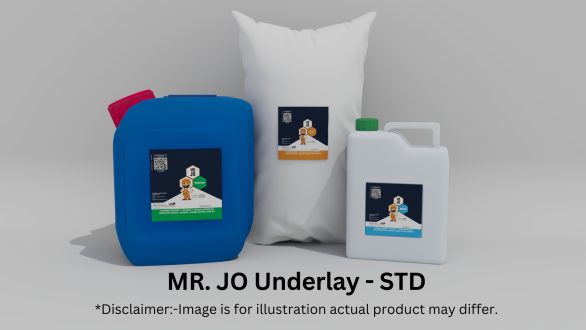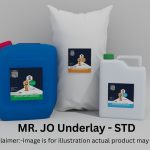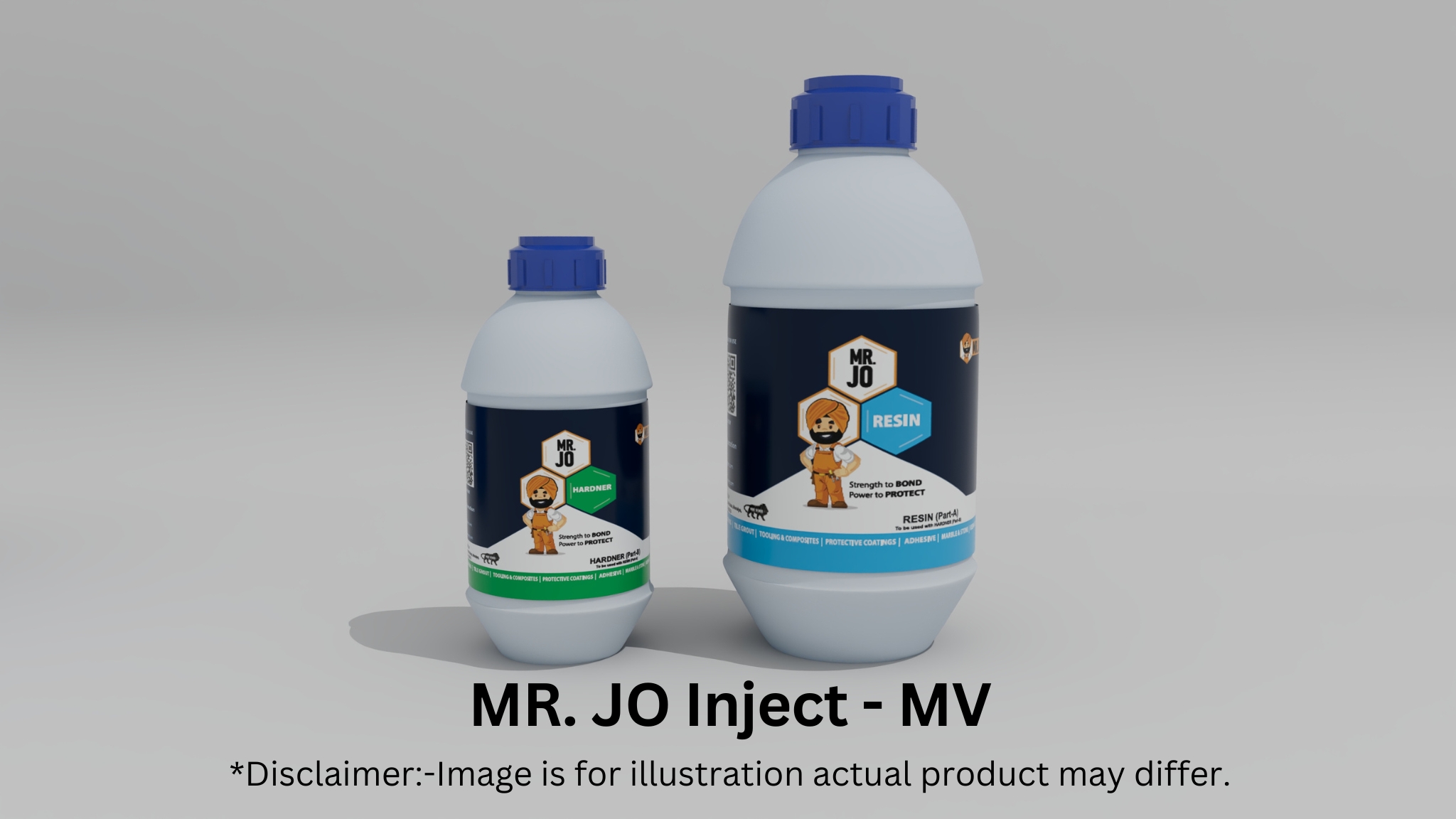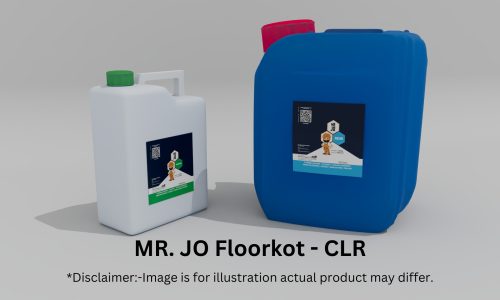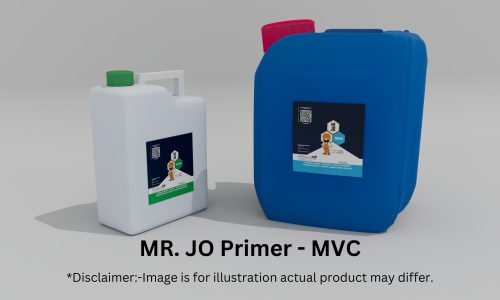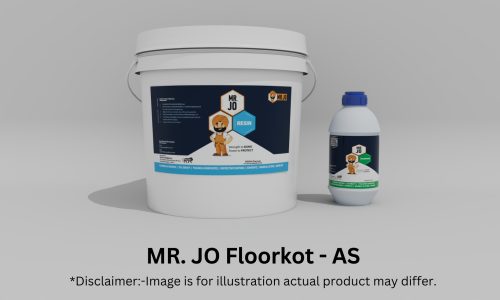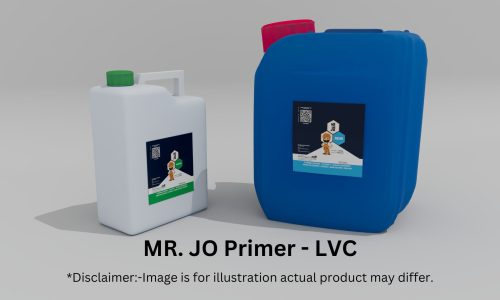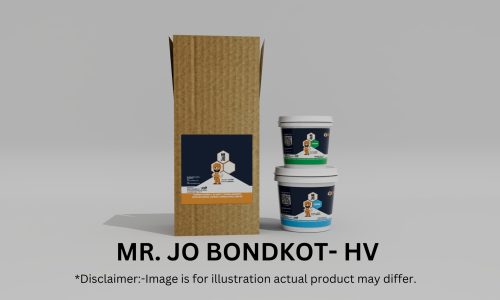MR. JO Underlay – STD
₹5,035.00 – ₹19,133.00 Inclusive of all taxes
Three component standard epoxy screed
- Description
- Properties
- Applications
- How To Use
- Technical Data Sheet(TDS)
- FAQs
Description
Mr. JO Underlay – STD is a three-part, solvent-free epoxy underlay. It offers strong adhesion and durability. also, This underlay works well for many flooring applications. It creates a smooth base for toppings and bedding. As a result, it boosts performance and extends the lifespan of the floor.
- Color: Neutral
- Pot life @25°C: 90-110 mins
- Mixing Ratio: 100:50:275 PBW
- Mixture consistency: Flowable
- Coverage: 1.8 kg/m2/mm
- Flooring
- Pavement
- Slope for drainage
- As a bedding to enhanced floor’s mechanical strength
- Remove all dust and debris by physical and mechanical means, prior to application of the product. surfaces should be freed from laitance and dust by sand-blasting.
- In case sand-blasting is not possible, thorough abrading with a hard wire brush should be preferable.
- Repair the surface if damaged. Allow 2-3 hours for surface of repaired area to dry. Choose a suitable product from Jpoxy’s JO range of Adhesives for repairing.
- Apply primer for better adhesion on substrate. Allow 4-5 hours for surface of repaired area to dry. Choose a suitable product from Jpoxy’s JO range of Primers.
- Mix all the three components provided in kit thoroughly for at least 2minutes. Apply the mix directly by pouring and spreading with the help of trowel.
- Allow 4-5 hour for surface to dry and 24 hours to achieve strength.
A1. It's a value-engineered flowable underlay, used below flooring in budget-sensitive projects where basic leveling and bonding is needed.
Q2. How does it compare to MR. JO Underlay-FLO?A2. STD is slightly less flowable, and more economical. Offers excellent coverage and workability for routine jobs.
Q3. What are MR. JO Underlay products used for?A3. All underlay products are epoxy-based screeds designed for:
- Leveling rough or uneven concrete floors
- Building thickness (1–6 mm) before epoxy topcoats
- Providing a strong, bonded base for self-leveling or roller-applied coatings
A4.
| Product | Type | Key Use Case | Flow | Thickness | Resistance |
|---|---|---|---|---|---|
| Flowable | Smooth, even underlayment | High | 1–3 mm | Standard | |
| TMP | Tampable | Slope formation, rough leveling | Low | 4–6 mm | Standard |
| STD | Flowable | Cost-sensitive jobs | Medium | 2–3 mm | Standard |
| CMR | Tampable | Chemically exposed zones | Low | 4–6 mm+ |
High (chemical) |
A5. MR. JO Underlay-STD is designed to be a cost-effective alternative to premium flowable systems like MR. JO Underlay-FLO. Ideal for large-scale flooring with budget constraints.
Q6. Which one should I use for chemical zones?A6. Use MR. JO Underlay-CMR, a chemically resistant screed, ideal for:
- ETPs/STPs
- Chemical plants
- Battery zones
- Coastal installations
A7. They're designed as underlays. For long-term durability, especially in industrial or exposed zones, overcoat with:
- MR. JO Floor SL series
- MR. JO EcoFloor series
- MR. JO Protectokot-CMR, CR, CSA or HBCR
A8. Yes — all four underlays are compatible with:
Q9. Do I need to use a primer before applying underlays?A9. Yes. Choose based on surface:
- MR. JO Primer-MVC or LVC for dry, well-prepared concrete
- MR. JO Primer-UPS for damp or underprepared surfaces
A10.
- FLO / STD: Pour, spread using trowel or notched rake, level out
- TMP / CMR: Place with trowel, tamp/compact manually
A11. Yes, especially if you're planning to overlay with screed, tile mortar, or non-epoxy layers. Broadcast dry quartz sand on the wet underlay before full cure.
Q12. Can I mix MR. JO ArtPigment into the underlays?A12. No. Underlays are not designed to be pigmented. They come in neutral (reddish-brown or grey) tones since they are not exposed.
Q13. What if there are cracks or potholes before underlay?A13. Use MR. JO Tecseal-CRP to patch and repair before primer and underlay application.
Q14. What are the typical pot lives?A14. All systems offer a working time of 30–40 minutes at 25°C. Always mix only as much as you can apply within that window.
Q15. When can I apply topcoat after underlay?A15. Typically after 8–12 hours, once surface is touch dry. Ensure it's clean and dust-free before applying topcoat.
Q16. Can I leave the underlay exposed temporarily?A16. Short term, yes — but for long-term protection, always apply a proper epoxy flooring or coating.
Q17. Can I use these screeds for repairs too?A17. Yes:
- TMP and CMR can be used for patch repairs or pothole filling
- Add extra sand or filler as needed for volume

